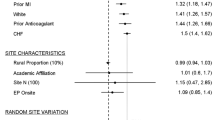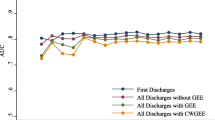Abstract
Hospital care focuses on improving patients’ long-term quality of life, yet hospital quality metrics typically focus on short-term processes. Attempting to understand a patient’s long-term process introduces sample selection bias since patients must survive the hospitalization in order to observe post-hospitalization outcomes. As a result, proper analysis of long-term outcomes should account for clustering, due to the hierarchical structure of hospital data, as well as sample selection bias. The objective of this paper was to evaluate random effect parameter estimation and higher-level ranking of long-term count outcomes and short-term selection processes in the presence of cluster and selection bias by comparing multilevel Poisson models, multilevel zero-inflated Poisson models, and multilevel Poisson sample selection models (MPSSMs) in a series of simulations. We simulated an outcome resembling a post-discharge Poisson count with a pre-specified selection process determining a patient’s hospitalization survival with each hospital having a unique effect on both processes. In order to clarify the methodology, we also analyzed a real-world hospital dataset involving a count outcome conditioned on the selection process of hospital survival. Across all simulations, the random effect parameter estimates were directly compared and the empirical Bayes estimates were extracted, ranked, and compared using the Spearman rank correlation. Results show that the MPSSM produces more accurate random effect parameter estimates and higher-level empirical Bayes ranks. When modeling multilevel effects on long-term count outcomes observed after a short-term selection process, higher-level effects are more reliably measured using MPSSMs.





Similar content being viewed by others
References
Bärnighausen, T., Bor, J., Wandira-Kazibwe, S., Canning, D.: Correcting HIV prevalence estimates for survey nonparticipation using Heckman-type selection models. Epidemiology 22(1), 27–35 (2011). doi:10.1097/EDE.0b013e3181ffa201
Buntin, M.B., Zaslavsky, A.M.: Too much ado about two-part models and transformation? Comparing methods of modeling Medicare expenditures. J Health Econ. 23(3), 525–542 (2004). doi:10.1016/j.jhealeco.2003.10.005
Cooper, D.J., Rosenfeld, J.V., Murray, L., Arabi, Y.M., Davies, A.R., D’Urso, P., Kossmann, T., Ponsford, J., Seppelt, I., Reilly, P., Wolfe, R., DECRA Trial Investigators, Australian and New Zealand Intensive Care Society Clinical Trials Group: Decompressive craniectomy in diffuse traumatic brain injury. N. Engl. J. Med. 364(16), 1493–1502 (2011). doi:10.1056/NEJMoa1102077
Elixhauser, A., Steiner, C., Harris, D.R., Coffey, R.M.: Comorbidity measures for use with administrative data. Med. Care 36(1), 8–27 (1998)
Flores-Lagunes, A., Schnier, K.E.: Estimation of sample selection models with spatial dependence. J. Appl. Econom. 27(2), 173–204 (2012). doi:10.1002/jae.1189
Hagihara, A., Hasegawa, M., Abe, T., Nagata, T., Wakata, T., Miyazaki, S.: Prehospital epinephrine use and survival among patients with out-of-hospital cardiac arrest. JAMA 307(11), 1161–1168 (2012). doi:10.1001/jama.2012.294
Hastie, T., Tibshirani, R., Friedman, J.: The Elements of Statistical Learning—Data Mining, Inference, and Prediction, 2nd edn. Springer, New York (2009)
Heckman, J.J.: Dummy endogenous variables in a simultaneous equation system. Econometrica 46, 931–959 (1978)
Hollander, M., Wolfe, D.A.: Nonparametric Statistical Methods, 2nd edn. Wiley, New York (1999)
Iwashyna, T.J., Angus, D.C.: Declining case fatality rates for severe sepsis: good data bring good news with ambiguous implications. JAMA 311(13), 1295–1297 (2014). doi:10.1001/jama.2014.2639
Iwashyna, T.J., Ely, E.W., Smith, D.M., et al.: Long-term cognitive impairment and functional disability among survivors of severe sepsis. J. Am. Med. Assoc. 304(16), 1787–1794 (2010). doi:10.1001/jama.2010.1553
Iwashyna, T.J., Odden, A., Rohde, J., Bonham, C., Kuhn, L., Malani, P., Chen, L., Flanders, S.: Identifying patients with severe sepsis using administrative claims: patient-level validation of the angus implementation of the international consensus conference definition of severe sepsis. Med. Care 52(6), e39–e43 (2014). doi:10.1097/MLR.0b013e318268ac86
Lachenbruch, P.: Analysis of data with excess zeros. Stat. Methods Med. Res. 11, 297–302 (2002). doi:10.1191/0962280202sm289ra
Marra, G., Radice, R.: Estimation of a regression spline sample selection model. Comput. Stat. Data Anal. 61, 158–173 (2013). doi:10.1016/j.csda.2012.12.010
Mikkelsen, M.E., Christie, J.D., Lanken, P.N., Biester, R.C., Thompson, B.T., Bellamy, S.L., Localio, A.R., Demissie, E., Hopkins, R.O., Angus, D.C.: The adult respiratory distress syndrome cognitive outcomes study: long-term neuropsychological function is survivors of acute lung injury. Am. J. Respir. Crit. Care Med. 185(12), 1307–1315 (2012). doi:10.1164/rccm.201111-2025OC
Miranda, A., Rabe-Hesketh, S.: Maximum likelihood estimation of endogenous switching and sample selection models for binary, ordinal, and count variables. Stata J. 6(3), 285–308 (2006)
Molas, M., Lesaffre, E.: Hurdle models for multilevel zero-inflated data via h-likelihood. Stat. Med. 29(30), 3294–3310 (2010). doi:10.1002/sim.3852
Morris, C.: Parametric empirical Bayes inference: theory and applications. J. Am. Stat. Assoc. 78(381), 47–55 (1983)
Prescott, H.C., Kepreos, K.M., Wiitala, W.L., Iwashyna, T.J.: Temporal changes in the influence of hospitals and regional healthcare networks on severe sepsis mortality. Crit. Care Med. (2015). doi:10.1097/CCM.0000000000000970
Rabe-Hesketh, S., Skrondal, A., Pickles, A.: GLLAMM Manual. University of California-Berkeley Division of Biostatistics Working Paper Series. Working Paper 160. http://www.bepress.com/ucbbiostat/paper160. (2004). Accessed 2 July 2014
Render, M.L., Deddens, J., Freybery, R., et al.: Veterans affairs intensive care unit risk adjustment model: validation, updating, recalibration. Crit. Care Med. 36(4), 1031–1042 (2008). doi:10.1097/CCM.0b013e318169f290
Semykina, A., Wooldridge, J.A.: Estimation of dynamic panel data models with sample selection. J. Appl. Econ. 28(1), 47–61 (2013). doi:10.1002/jae.1266
Skrondal, A., Rabe-Hesketh, S.: Prediction in multilevel generalized linear models. J R Stat Soc 172(Part 3), 659–687 (2009)
Tomlinson, G., Detsky, A.: Composite end points in randomized trials: there is no free lunch. J. Am. Stat. Assoc. 303(3), 267–268 (2010). doi:10.1001/jama.2009.2017
Wilde, J.: Identification of multiple equation probit models with endogenous dummy regressors. Econ. Lett. 63(3), 309–312 (2000). doi:10.1016/S0165-1765(00)00320-7
Yuan, Y., Yen, S.T.: Alcohol consumption by individuals in the United States: a sample selection approach. Appl. Econ. Lett. 19(14), 1353–1358 (2012). doi:10.1080/13504851.2011.628290
Acknowledgments
This work was supported by VA HSR&D IIR 11-109. The authors’ opinions do not necessarily represent the views of the US Department of Veterans Affairs or the US Government.
Author information
Authors and Affiliations
Corresponding author
Electronic supplementary material
Below is the link to the electronic supplementary material.
Rights and permissions
About this article
Cite this article
Kepreos, K.M., Wiitala, W.L., Sales, A.E. et al. Multilevel Poisson sample selection models and alternative methods for estimating hospital effects on long-term outcomes. Health Serv Outcomes Res Method 15, 204–222 (2015). https://doi.org/10.1007/s10742-015-0139-z
Received:
Revised:
Accepted:
Published:
Issue Date:
DOI: https://doi.org/10.1007/s10742-015-0139-z




